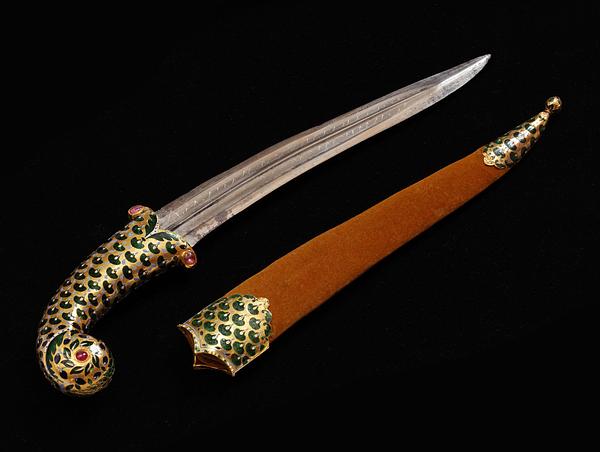Dagger with gold hilt inlaid with enamel and rubies; matching scabbard
Northern India; 18th century
L: 36 cm
Men in Mughal India wore jewelry in profusion: turban ornaments, necklaces, and rings. The same conspicuous magnificence that characterizes much of this jewelry for men was also expressed in the Mughals’ weapons – the types of objects that were men’s most important jewelry-like embellishment in the rest of the Islamic world.
The hilt of this elegant dagger was inlaid with a dense pattern of stylized flowers in green, white, and light-blue enamel. The rudimentary guard and knob are decorated with leaves and a few rubies that make the knob resemble a head. Plant decorations of this kind are found on much Indian decorative art from the 18th century.
Inv. no. 32/1980
Published in:
Spink & Son: Islamic art from India, London 1980, cat.no.16, pp. 7 and 15;
Kjeld von Folsach: Islamic art. The David Collection, Copenhagen 1990, cat.no. 366;
Stephen Markel: “Luxury arts of Lucknow” in Arts of Asia, 1993, 23: March-April, lss. 108-121, pp. 116-117;
Kjeld von Folsach, Torben Lundbæk and Peder Mortensen (eds.): Sultan, Shah and Great Mughal: the history and culture of the Islamic world, The National Museum, Copenhagen 1996, cat.no. 340;
Kjeld von Folsach: Art from the World of Islam in The David Collection, Copenhagen 2001, cat.no. 569;
Ravinder Reddy: Arms and armour of India, Nepal and Sri Lanka: types, decoration and symbolism, London 2018, p. 212;
Kjeld von Folsach, Joachim Meyer and Peter Wandel: Fighting, Hunting, Impressing. Arms and Armour from the Islamic World 1500-1850, The David Collection, Copenhagen 2021, cat.no. 39;
Mentioned in Augustin, Bernd: ”Die frühe Bidri-Ware: indische Zink und seine Tauschierung” in Indo-Asiatische Zeitschrift, Sonderheft, 2023, p. 31;


